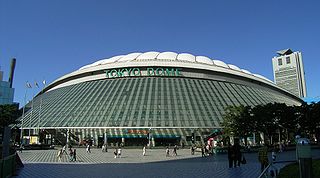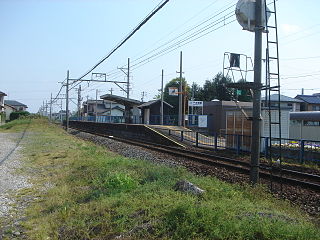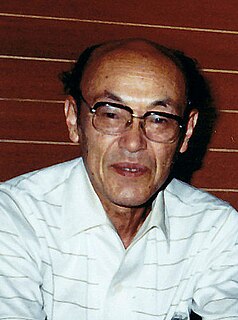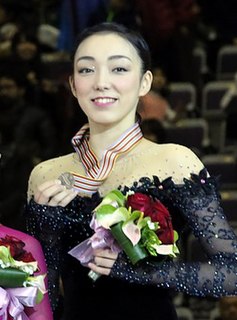
Bunkyō is a special ward located in Tokyo, Japan. Situated in the middle of the ward area, Bunkyō is a residential and educational center. Beginning in the Meiji period, literati like Natsume Sōseki, as well as scholars and politicians have lived there. Bunkyō is home to the Tokyo Dome, Judo's Kōdōkan, and the University of Tokyo's Hongo Campus. Bunkyō has a sister-city relationship with Kaiserslautern in the Rhineland-Palatinate of Germany.

Tōei is a town located in Kitashitara District, Aichi Prefecture, Japan. As of 1 October 2019, the town had an estimated population of 3,033 in 1438 households, and a population density of 24.6 persons per km2. The total area of the town was 123.38 square kilometres (47.64 sq mi).
Kunihiro Fujioka, better known by his stage name Hiroshi Fujioka, is a Japanese actor known for playing the hero Takeshi Hongo in the tokusatsu superhero series Kamen Rider, and later the Sega Saturn mascot Segata Sanshiro. Fujioka is a cultural icon in Japan, even having the minor planet 12408 Fujioka, discovered by Akimasa Nakamura, named in his honor. Fujioka writes his name with the ideographic comma at the end, saying "It is meant to remind me to reconsider myself and what it is that I need to achieve. It shows that I am not yet finished with my tasks and must continue working toward their accomplishment."

Gamera vs. Barugon is a 1966 Japanese kaiju film directed by Shigeo Tanaka, with special effects by Noriaki Yuasa and Kazufumi Fujii. Produced by Daiei Film, it is the second entry in the Gamera franchise, and stars Kōjirō Hongō, Kyōko Enami, and Yūzō Hayakawa, with Teruo Aragaki as Gamera. In the film, Gamera returns to Earth to battle a reptilian monster born out of an opal brought to Japan by greedy entrepreneurs.
Kanata Hongō is a Japanese actor, voice actor and model. He is part of Stardust Promotion and has appeared several times in music videos, movies, TV series, and magazines. His major breakthrough role was as Ryoma Echizen in the live-action film adaptation of The Prince of Tennis and became even more widely known when he was cast as Shin in Nana 2. In television, his most notable role was as Hinata in Himitsu no Hanazono and he starred in Seigi no Mikata. For the live-action feature film adaptation of Attack on Titan, he portrayed Armin Arlert. He has also been involved in anime voice acting as the lead character Ryōta Sakamoto in Btooom!.

Kamen Rider: The Next is a 2007 Japanese tokusatsu superhero film directed by Ryuta Tasaki and written by Toshiki Inoue. The film was released on October 27, 2007. The film borrows elements from the Kamen Rider V3 television series and is a sequel to the Kamen Rider: The First movie. Actor Kazuki Kato, who had previously portrayed Daisuke Kazama/Kamen Rider Drake in Kamen Rider Kabuto, portrayed Shiro Kazami/Kamen Rider V3. Both Masaya Kikawada and Hassei Takano reprise their roles as Takeshi Hongo/Kamen Rider 1 and Hayato Ichimonji/Kamen Rider 2, respectively. It was given a PG-12 rating for its brief nudity and violence.

Hongō-sanchōme Station is a railway station in Bunkyō, Tokyo, Japan, jointly operated by the Tokyo subway operators Tokyo Metro and Toei Subway. Part of the station originally lay within the Hongō-sanchōme district of Bunkyō Ward when the station was first opened, but following rezoning in 1965, the address of the station became Hongō-nichōme.

Hongō Station is an above ground metro station located in Meitō-ku, Nagoya, Aichi Prefecture, Japan operated by the Nagoya Municipal Subway's Higashiyama Line. It is located 19.3 rail kilometers from the terminus of the Higashiyama Line at Takabata Station.

Mino-Hongō Station is a railway station in the town of Ikeda, Ibi District, Gifu Prefecture, Japan, operated by the private railway operator Yōrō Railway.

Hongō Station is a railway station in Mihara, Hiroshima Prefecture, Japan, operated by West Japan Railway Company.
Mitsuru Hongo is a Japanese anime director of television and film.

Tsuguo Hongo was a Japanese mycologist who specialized in the biogeography and taxonomy of Agaricales. Hongo entered the Department of Biology at what is now Hiroshima University in 1943, where he studied botany until graduating in 1946 with a B.Sc. Hongo received his Ph.D. degree, entitled "Agaricales of Japan", from Kyoto University in 1961 while working under Dr. Shiro Kitamura.

Wakasa-Hongō Station is a railway station in the town of Ōi, Ōi District, Fukui Prefecture, Japan, operated by West Japan Railway Company.

Ina-Hongō Station is a railway station on the Iida Line in the town of Iijma, Kamiina District Nagano Prefecture, Japan, operated by Central Japan Railway Company.

Aizu-Hongō Station is a railway station on the Tadami Line in the city of Aizuwakamatsu, Fukushima Prefecture, Japan, operated by East Japan Railway Company.

Rika Hongo is a Japanese retired competitive figure skater who is a two-time (2015–16) Four Continents bronze medalist, 2014 Rostelecom Cup champion, 2015 Finlandia Trophy champion and 2014–15 Japanese national silver medalist.
Hongō Junior and Senior High School is a high school in Hongō, Tokyo, Japan. It was founded in 1923.

Hongō Station is a railway station in the northeastern part of city of Nagano, Japan, in area called Miwa (三輪). The station is operated by the private railway operating company Nagano Electric Railway.
Hongo Tameike is an earthen dam located in Nara prefecture in Japan. The dam is used for agriculture. The catchment area of the dam is 4.3 km2. The dam impounds about 4 ha of land when full and can store 512 thousand cubic meters of water. The construction of the dam was completed in 1935.














